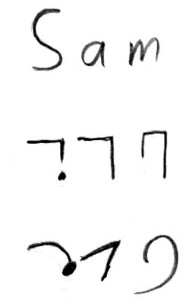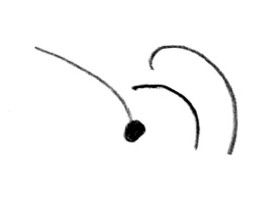Ambiguarty

Today I happened upon the marvellous Elian Script. It's a kind of pigpen alphabet, where each letter corresponds to a position in a tic-tac-toe grid. The first nine letters are represented with equal-length lines. The next nine by unequal-length lines, and the last nine (well, eight) represented by unequal-length lines with a mark of some kind. The rules are so simple that they leave an enormous range of calligraphic expression, and the results can be really striking.
It got me thinking about the idea that there's a certain fundamental relationship between ambiguity and art. What I mean is that art relies on making creative choices that can't exist if those choices are prescribed by necessity. So I wouldn't describe the integers as art, for example; there's really only one possible set of integers. But I wouldn't be totally opposed to more abstract mathematics being described as art, to the extent that there's no particular right answer to a lot of high-level maths.
I've heard it argued that languages are redundant to serve as a kind of error correction. You can say "he is at the beach", but if you say "he are at the beach" people will look at you confused - but why? It's not like the meaning is unclear. On the other hand, maybe you meant to say "we are at the beach". The redundancy works as a kind of fallback so you can catch problems. Some constructed languages set out to remove that redundancy, at the cost of less error correction.
But that error correction actually provides an interesting source of artistic choice. You can break the rules of grammar and rely on there being enough redundant information to fill in the blanks. A lot of poetry relies on creative breaking of traditional grammatical rules. But even without breaking rules there's a lot of creative choice between valid but equivalent words and structures. You can order words in numerous different ways. There are numerous different ways you can order words. The different ways you can order words are numerous.
And there's maybe no better example of ambiguity and art going together than the delightful phenomenon of QR code art. QR codes are designed with a high degree of error correction (much higher than English) so that they can be easily identified even when captured by bad phone cameras in bad lighting conditions, out of focus, and tilted or rotated in crazy ways. All that ambiguity gives you a lot of space to play in.
Elian Script fascinates me because I'm not used to (western) character systems having that much ambiguity. They're possibly the most strictly symbolic system I can think of. Even calligraphy is fairly limited by having to faithfully represent so many different shapes. By contrast, having such a minimal and distinctive set of actual constraints, Elian Script leaves so much choice and so little direction that you feel obligated to create your own.
